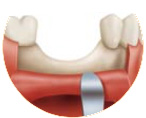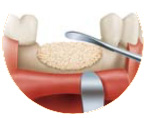What can I expect from a Bone Grafting procedure?
Prior to your procedure, your doctor will go over any pre-operative instructions you should follow, as well as any specifics about the surgical process. The following general steps may be included:

1. A local anesthetic is applied to the grafting site.

2. A small opening is made in the area where bone is needed.

3. The grafting material is gently placed within the grafting site, alongside the existing bone, and stabilized with a protective covering.

4. The area is sutured — stitches will either dissolve or be removed by your doctor in 7-10 days.
Major & Minor Bone Grafting
Over a period of time, the jawbone associated with missing teeth atrophies or is reabsorbed. This often leaves a condition in which there is poor quality and quantity of bone suitable for placement of dental implants. In the past, these situations made patients poor candidates for placement of dental implants.
Today, we have the ability to replace bone where needed. This not only gives us the opportunity to place implants of proper length and width, it also gives us a chance to restore quantity and quality of bone for the best possible functionality and an excellent aesthetic appearance.
• Minor Bone Grafting
Bone grafting can repair implant sites with inadequate bone structure due to previous extractions, gum disease or injuries. Socket preservation grafts (at same time as tooth extraction). Sinus grafting to build height in posterior (back) of upper jaw and ridge augmentation (to gain width) are the most common procedures used to reconstruct the dental arches in preparation for implants. The bone is either obtained from a tissue bank (most common and preferred) or your own bone is taken from the jaw, hip or tibia (below the knee). In addition, special membranes may be utilized that dissolve under the tissue and protect the bone graft and encourage bone regeneration. This is called guided bone regeneration or guided tissue regeneration.
• Major Bone Grafting
Major bone grafts are typically performed to repair defects of the jaws. These defects may arise as a result of traumatic injuries, tumor surgery, or congenital defects. Large defects are repaired using the patient’s own bone. This bone is harvested from a number of different sites depending on the size of the defect. The skull (cranium), hip (iliac crest), and lateral knee (tibia), are common donor sites. These procedures are routinely performed in an operating room and require a hospital stay.
